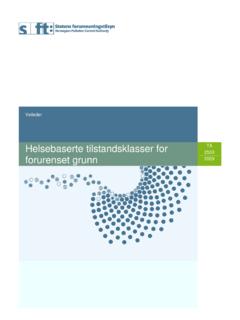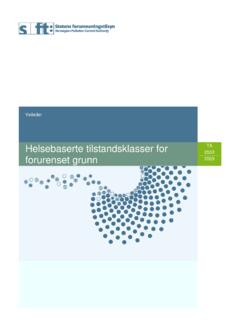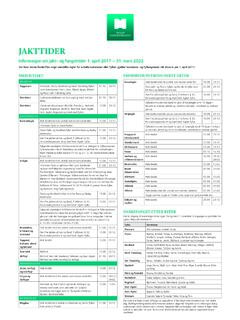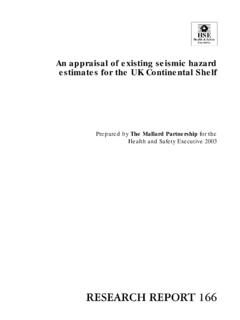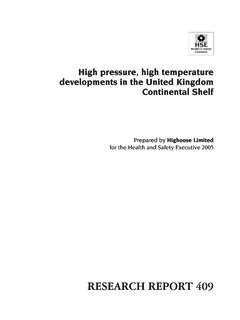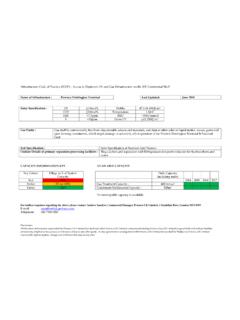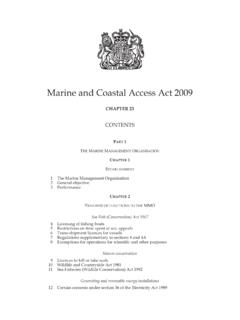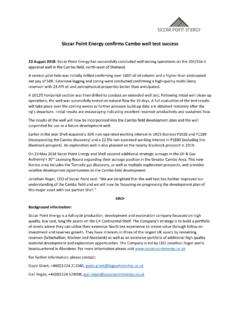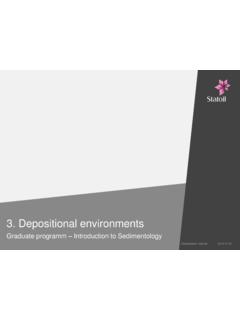Transcription of Decommissioning of offshore installations - Miljødirektoratet
1 Report Decommissioning of offshore TA. 2761. installations 2011. 1. Foreword This report was drawn up by the Climate and Pollution Agency, with input from the Norwegian Petroleum Directorate, the Directorate of Health, the Directorate of Fisheries and the Norwegian Radiation Protection Authority, and deals with the environmental impacts associated with the Decommissioning of offshore installations . We would like to thank ConocoPhillips and Total for sharing the experience they have gained from the Ekofisk and Frigg Decommissioning projects respectively. In addition, we would like to thank the staff at AS Milj base Vats and Aker Stord for arranging very successful visits to the two Decommissioning yards and providing a thorough review of their activities.
2 New legislation on the handling and storage of radioactive substances came into force 1. January 2011. This version of the report is updated to reflect this new regulation and will therefore in some chapters differ from the Norwegian version. The table comparison of some elements of the permits held by the four Decommissioning facilities is also updated. Climate and Pollution Agency, Oslo, February 2011. Signe N mdal Director, Department of Climate and Industry Source: Aker Stord Figure 1 The Frigg field showing Decommissioning in progress 2. Contents 1. Foreword .. 2. 2. Summary .. 4. 3. Introduction .. 7. The assignment .. 7. Background .. 7. 4. Projections for Decommissioning of offshore installations .. 10. Timeframe and weight estimates.
3 10. Weight estimates and Decommissioning capacity in other countries .. 13. Types and quantities of waste material for recycling .. 15. Low specific activity (LSA) material from Decommissioning of offshore installations .. 16. 5. Decommissioning capacity .. 19. Current Decommissioning 19. Decommissioning capacity in the future .. 23. 6. Environmental concerns .. 25. offshore .. 25. 26. 7. Other concerns .. 30. Public health .. 30. Fisheries and aquaculture .. 32. Financial 34. 8. National 35. The Petroleum Activities Act (Ministry of Petroleum and Energy) .. 35. Provisions of the Pollution Control Act relating to permits for demolition and recycling (County Governors' offices) .. 36. Provisions of the Pollution Control Act relating to import and export of waste (Climate and Pollution Agency).
4 38. The Act relating to ports and navigable waters (municipalities/Norwegian Coastal Administration) .. 39. The Planning and Building Act (municipalities).. 39. Municipal Health Services Act .. 41. New legislation relating to radioactive 41. 9. International rules .. 43. 10. Recommendations and proposals for further work .. 45. 3. 2. Summary The Ministry of the Environment commissioned the Climate and Pollution Agency to examine the environmental impacts associated with the Decommissioning of offshore installations (demolition and recycling). This has involved an assessment of the volumes and types of waste material and of Decommissioning capacity in Norway now and in the future. This report also presents proposals for measures and instruments to address environmental and other concerns that arise in connection with the Decommissioning of offshore installations .
5 At present, Norway has four Decommissioning facilities for offshore installations , three of which are currently involved in Decommissioning projects. Waste treatment plants of this kind are required to hold permits under the Pollution Control Act. The permit system allows the pollution control authority to tailor the requirements in a specific permit by evaluating conditions and limits for releases of pollutants on a case-to-case basis, and the Act also provides for requirements to be tightened up in line with the development of best available techniques (BAT). The environmental risks posed by Decommissioning facilities are much the same as those from process industries and other waste treatment plants that are regulated by means of individual permits.
6 Strict requirements are intended to ensure that environmental and health concerns are taken into account. The review of the four Norwegian Decommissioning facilities in connection with this report shows that the degree to which requirements need to be tightened up varies from one facility to another. The permit for the Vats yard is newest and contains the strictest conditions. The Climate and Pollution Agency recommends a number of measures and requirements that should be considered in the regulation of Decommissioning facilities for offshore installations . These facilities need sound expertise to be able to identify and deal with different types of waste, including hazardous waste such as heavy metals, other hazardous substances, low specific activity (LSA) radioactive material and asbestos.
7 Facilities must be designed to allow safe handling of such waste, with no risk of runoff or infiltration into the soil. In addition, a Decommissioning facility should have an effective collection system and an on-site treatment plant for contaminated water, including surface water. Each facility must have a sampling and analysis programme to monitor releases of the most relevant pollutants. The need for an environmental monitoring programme to follow developments in the recipient should also be considered. Other factors that must be closely monitored include noise and releases to air in connection with metal cutting and other operations. Moreover, Decommissioning contracts must ensure that the costs of handling hazardous waste are met by the offshore operators.
8 When Decommissioning facilities for offshore installations are being sited, other interests must also be taken into account; for example, the use of nearby areas for housing, holiday housing or recreation. In addition, the implications for other sectors such as fisheries and agriculture must be taken into consideration. These are important issues that the municipalities must consider when preparing zoning plans and drawing up environmental impact assessments. In many cases, a regional authority is in a better position than a national one to make overall, cross-sectoral assessments of developments within the region. Nevertheless, the report recommends transferring the authority for regulating Decommissioning facilities for offshore installations from the County Governors to the Climate and Pollution Agency.
9 Regulating these facilities requires special expertise and overall assessments, and is best dealt with at 4. central level. When new regulations have entered into force, the Norwegian Radiation Protection Authority will be responsible for regulating radioactive releases and waste from the same facilities under the Pollution Control Act. This will require close coordination between the two agencies and makes it more important to transfer authority to the Climate and Pollution Agency. In addition, Decommissioning of offshore facilities involves the oil and gas industry and may involve the import and export of waste, both areas where the Climate and Pollution Agency is already the competent authority. Norway's current Decommissioning capacity will be sufficient to handle the projected Decommissioning volumes in the period up to 2020, about 50 000 80 000 tonnes of steel a year.
10 Around 2020, there is expected to be a steep increase, so that about 200 000 tonnes of steel a year will need to be dismantled and recycled. At this stage, it may be appropriate to establish new Decommissioning facilities. There is a great deal of uncertainty associated with the timing of Decommissioning of installations from the different fields. This depends on many factors, including oil prices, maintenance costs and the development of new technology for extracting oil and gas. The trend today is for the lifetimes of fields and installations to be extended beyond what was originally planned. The costs of Decommissioning the roughly 500 installations on the Norwegian continental shelf are uncertain, but a preliminary estimate suggests that the overall cost will be about NOK 160 billion.


